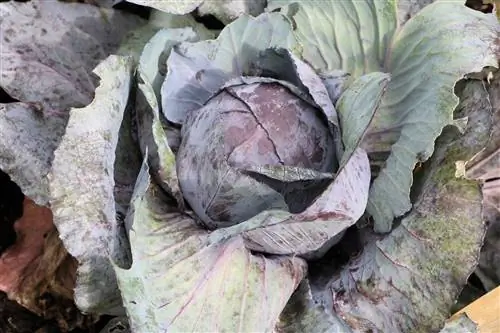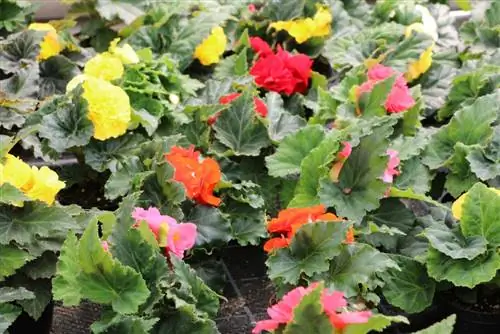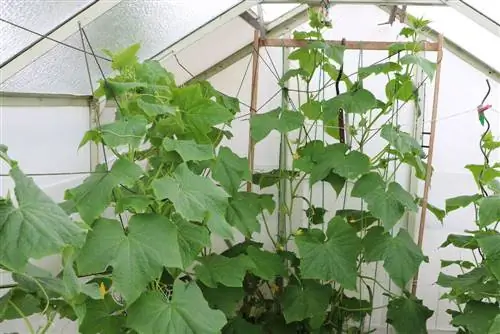- Author admin [email protected].
- Public 2023-12-17 03:39.
- Last modified 2025-06-01 06:48.
Red cabbage is a popular vegetable that is often on the menu, especially in winter. It can be eaten as a cooked vegetable or in a salad. Other names for red cabbage are also red cabbage or red cabbage.
It also has the property of being very he althy. It contains a lot of vitamin C, as well as vitamins A and E. It is also rich in iron and calcium.
If you would like to plant red cabbage in your own garden, you have the option of sowing the seeds during cultivation and releasing the small plants later. You can also buy the small plants directly from the gardener.
variety selection
Before starting the actual work of cultivation and care, you need to decide which variety you want to grow. Red cabbage is usually divided into three different types.
There are early and mid-late varieties of cabbage. These are particularly suitable for immediate consumption. On the other hand, there is the late type of red cabbage. This is used more for storage and overwintering.
Soil conditions and selection of the bed
- Before planting, the soil should be well dug and loosened.
- If possible, this can also be done in the fall before cultivation.
- You should choose a bed on which NO cabbage species have been grown in the last 3 years, this will prevent pests from attacking the cabbage.
- If you have decided on early red cabbage, you will need more sandy soil.
- If you want to grow mid-late or late cabbage, the soil should be loamy.
- Good neighboring plants for red cabbage are various types of lettuce, herbs, leeks and celery.
Fertilization of the soil
Before planting, you can use a lime fertilizer for the soil to avoid soil acidification. This fertilizer also serves to prevent clubroot, a plant disease that can affect the herb. During the growth phase of the cabbage, nitrogen and potash fertilizer is recommended.
Location of the bed
Red cabbage loves the sun, but it can also grow well in partial shade. If possible, you should choose a place that is protected from the wind.
Sowing and planting
- There are some differences between the different types of cabbage.
- The seeds of early red cabbage can be sown indoors from February. The best way to do this is to use a planting bowl. The herb needs normal room temperature to germinate.
- Planting takes place from the beginning of April when there is no longer any night frost.
- For mid-late and late red cabbage, the seeds can be scattered directly into the garden bed.
- This can be done from the beginning of April. Planting should then take place by the end of May at the latest.
- For all types of cabbage, the grains should be sown thinly and then covered with a little soil.
- If the seedlings have grown around 3-4 leaves, they should be set apart about 6 - 8 cm.
- When planting later, pay attention to the distance between the individual red cabbage plants. For early red cabbage this is approx. 40cm, for medium-late and late red cabbage it is approx. 60cm.
- The root neck should be covered with soil after moving.
Care
The bed requires consistently moist soil, so it should be watered heavily on a regular basis. Since red cabbage is a root crop, you loosen the soil every now and then. Regular removal of weeds is also important.
Harvest
The harvest of early red cabbage can begin from the beginning of June, while the mid-late and late cabbage can only be harvested from the beginning of August.
The right time has come when you are satisfied with the size of the cabbages. You can harvest until the first frost, depending on which type of cabbage you have grown. However, the red cabbage should not be left in the bed for too long, otherwise it could burst open.
When harvesting, the outer leaves are removed and the head of cabbage is dug up. If you want to store the red cabbage, the stalk must also be harvested.
Storage and overwintering
The refrigerator is suitable for short-term storage. Here the red cabbage stays fresh for around 3 - 4 weeks. Once a head of cabbage has been cut, it can be wrapped in cling film. The best way to overwinter the red cabbage is in cellars that are dark and dry.
The stalk is then wrapped with a thin string, which can also be secured with adhesive tape. A thick rope is then stretched through the cellar on which the cabbages are hung upside down. This is necessary so that the herb cannot accumulate water and therefore not become moldy. If tensioning a rope in your basement is not possible, you can also store the heads in boxes and cover them with straw or jute sacks. However, you then have to check regularly to ensure that no moisture or mold forms.
Diseases and pests
Red cabbage is often attacked by aphids and flea beetles. To counteract the infestation, it is important to always keep the soil moist.
Other pests include the caterpillars of the cabbage white butterfly, a type of butterfly. Bird protection nets can be stretched for protection. Another option is to cover with fleece, which allows water and light to pass through. Common diseases of red cabbage include clubroot, downy mildew and leaf spot. As a preventive measure, dead plant parts should be removed and the soil should be limed.
Some hobby gardeners may have been afraid of growing red cabbage or the work it entails. But this is not necessary if you know some background information. If these are taken into account, delicious red cabbage can be harvested in autumn.






